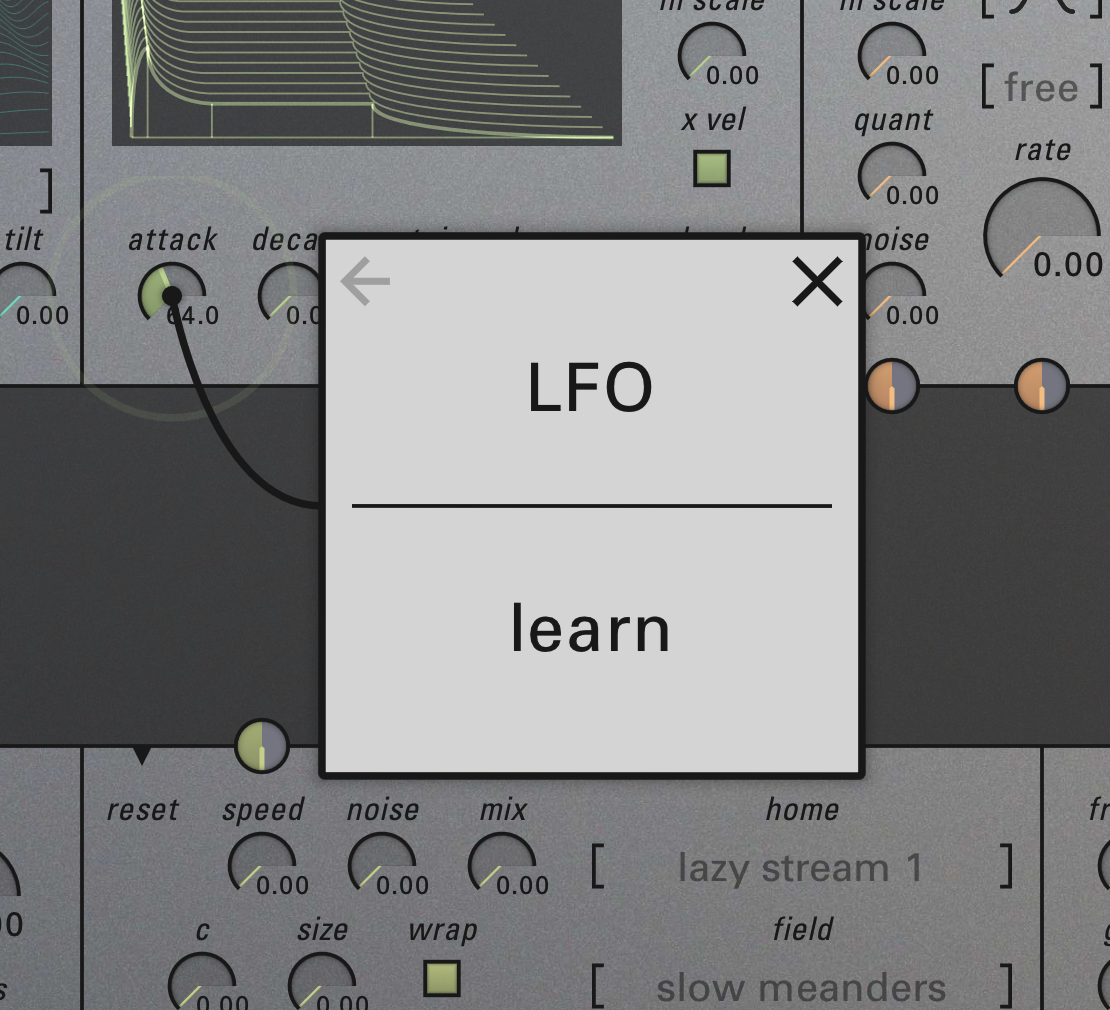
Sumu is an additive instrument that I've had in the works for a long time. Now that it's nearing completion and heading towards a public beta soon I'm going to break with the way I normally do things and put some detailed info out ahead of its release.
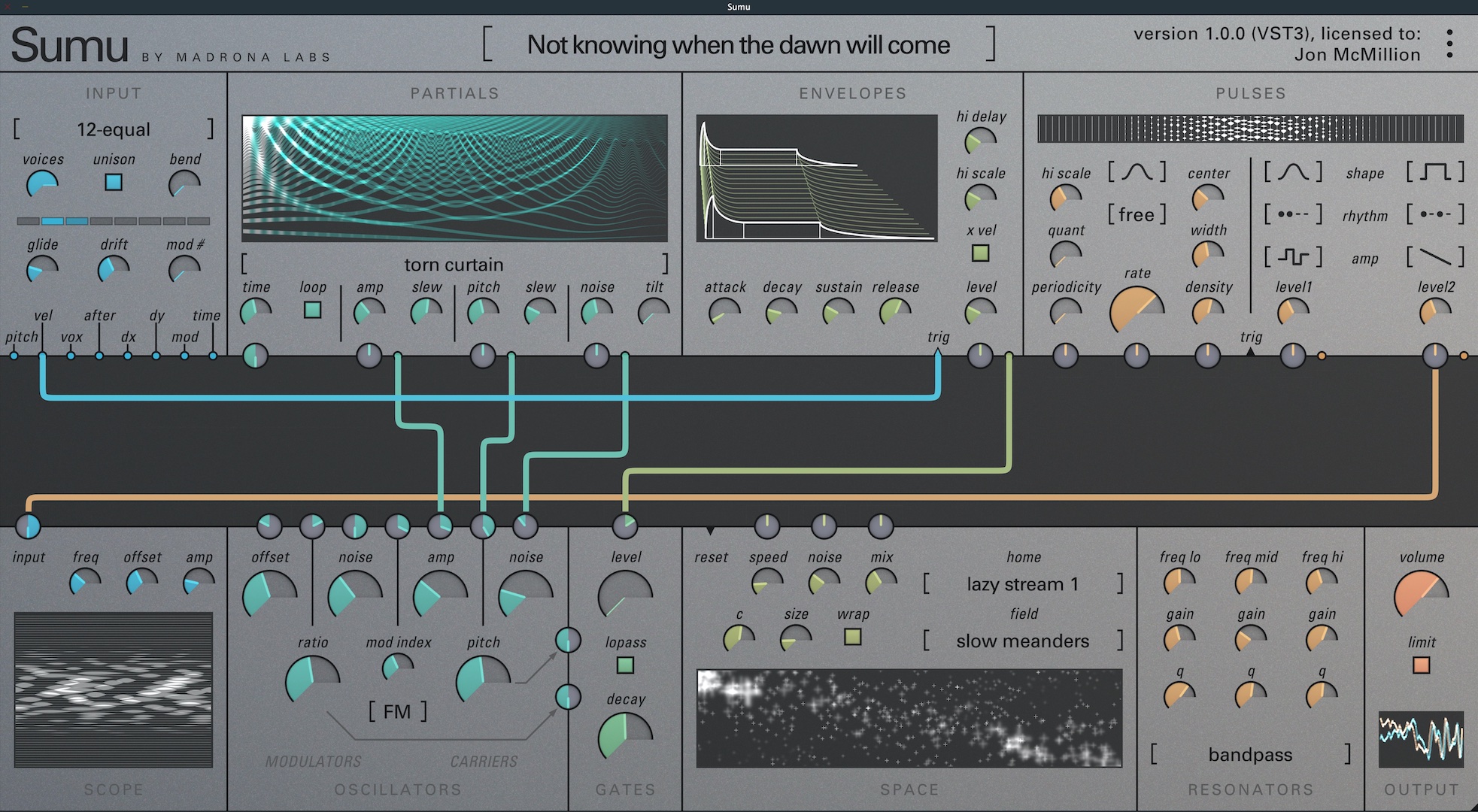
Sumu is another semi-modular instrument. It shares the general appearance of its patcher-in-the-center design with Aalto, Kaivo and Virta. As you can see, it's on the more complex end of the spectrum like Kaivo. Everything is visible at once and there are no tabs or menu pages to navigate, which suits the way I like to program a synthesizer tweaking a little something here, a little something there.
In the same way that Kaivo brought two different and compatible kinds of synthesis together, combining granular synthesis with physical modeling, Sumu combines advanced additive synthesis with FM synthesis.
What's most different about Sumu compared to my other synths is that the signals in the patcher are not just one channel of data, but 64—one for each partial in a sound! By keeping all these channels of data independent and still using the same patching interface, Sumu offers a very usable entry point into additive synthesis, and a range of musical possibilities that have only been approachable with high-end or academic tools or just coding everything yourself... until now.
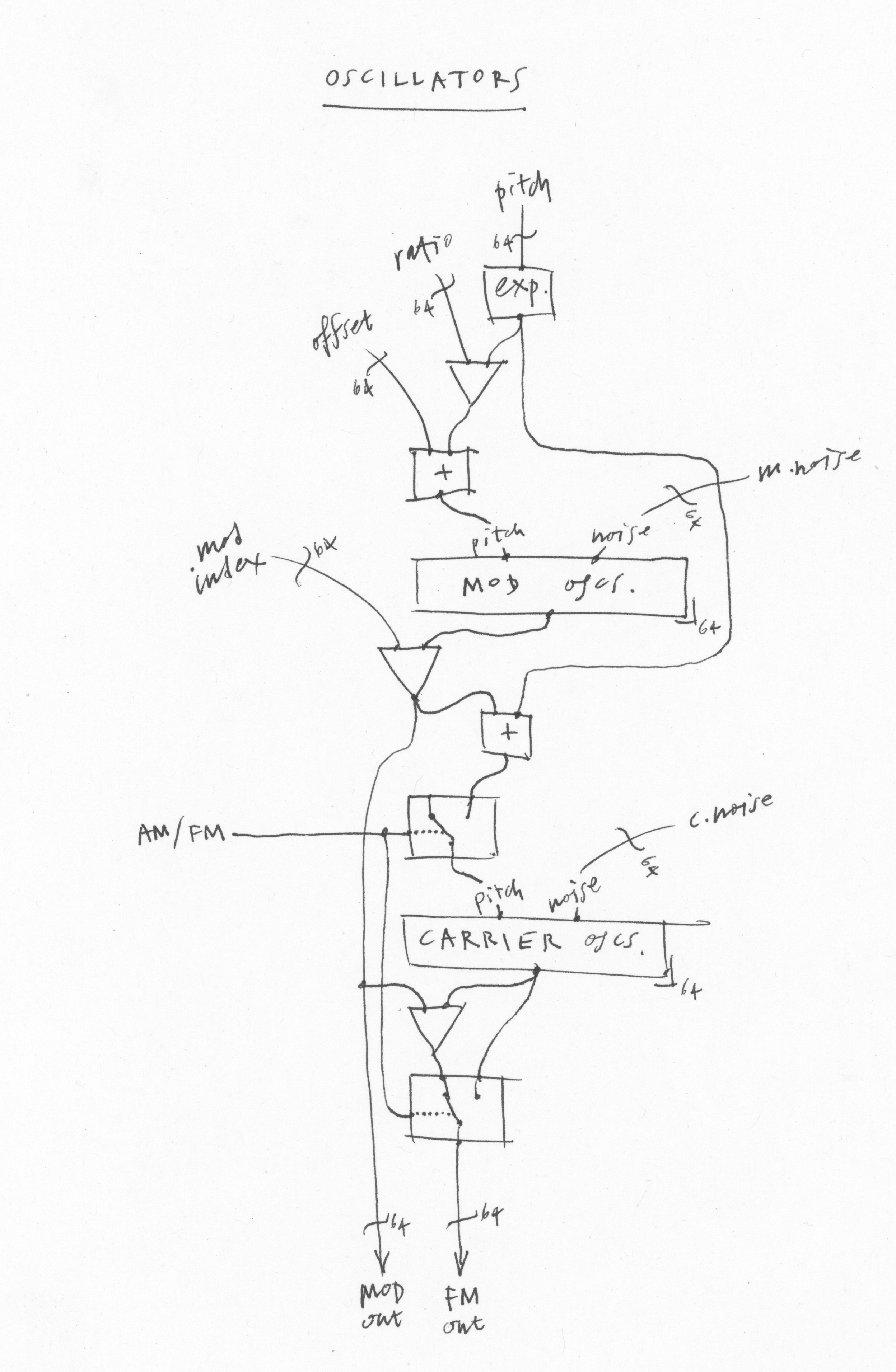
Each of Sumu's oscillators is the simplest possible kind of FM:a single carrier+modulator pair. And the modulator can produce a variable amount of noise, which like the modulation ratio and depth can be controlled individually per oscillator. In a single voice there are 64 such pairs. Obviously a lot of sounds are possible with this setup—in fact, with the right parameters varying appropriately we can reproduce any musical sound very faithfully with this kind of oscillator bank.
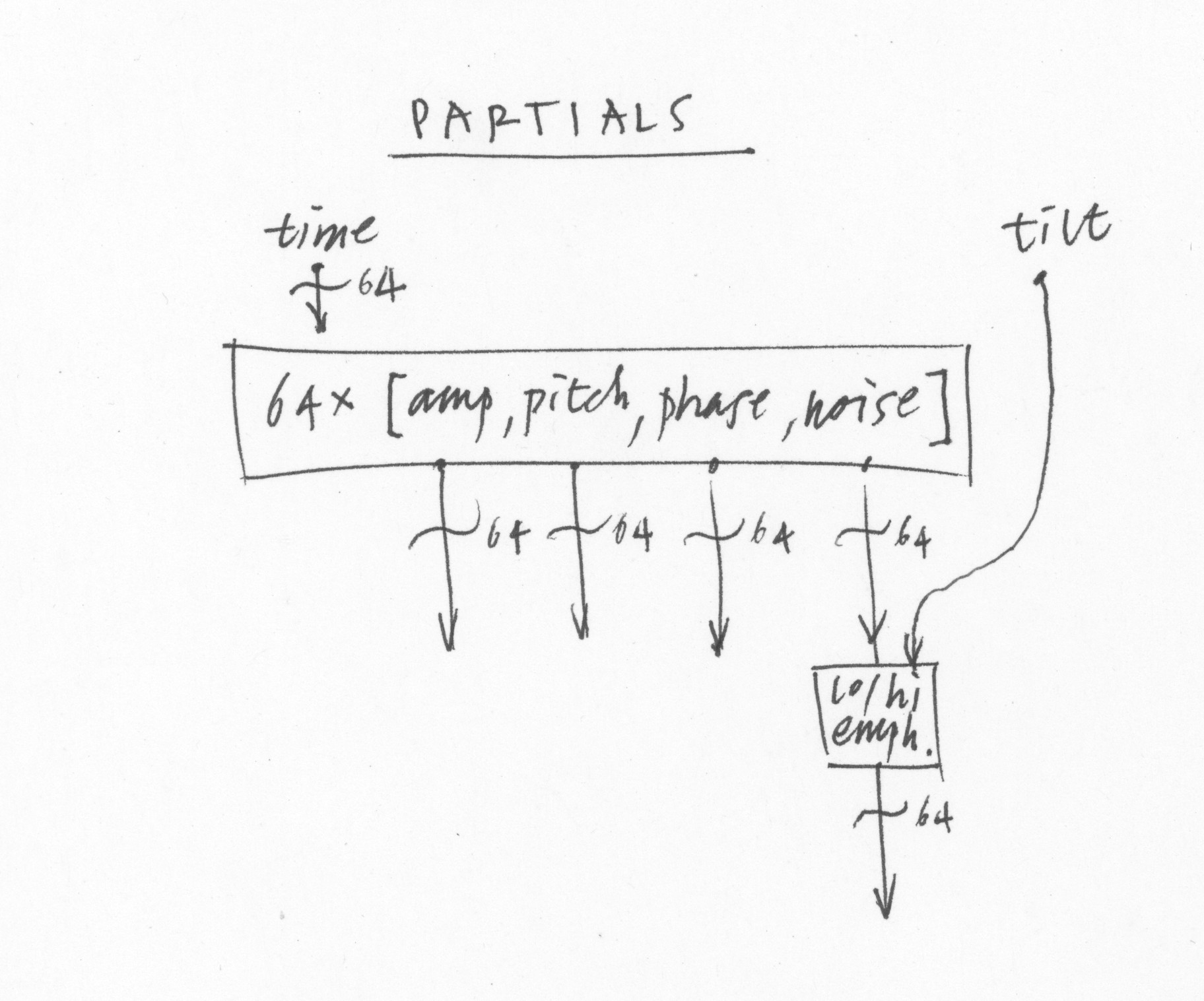
There are a few ways of generating all of those control channels without the kind of painful per-partial editing that some of the first digital synths used. The first is the PARTIALS module up top, where you can see a diagram of all the 64 partials over time. This is like a sonogram style of diagram where x is time, y is pitch, and thickness of each like is amplitude. There is also an additional axis for noisiness at each partial.
A separate application will use the open-source Loris work by Kelly Fitz and Lippold Haken to analyze sounds and create partial maps.
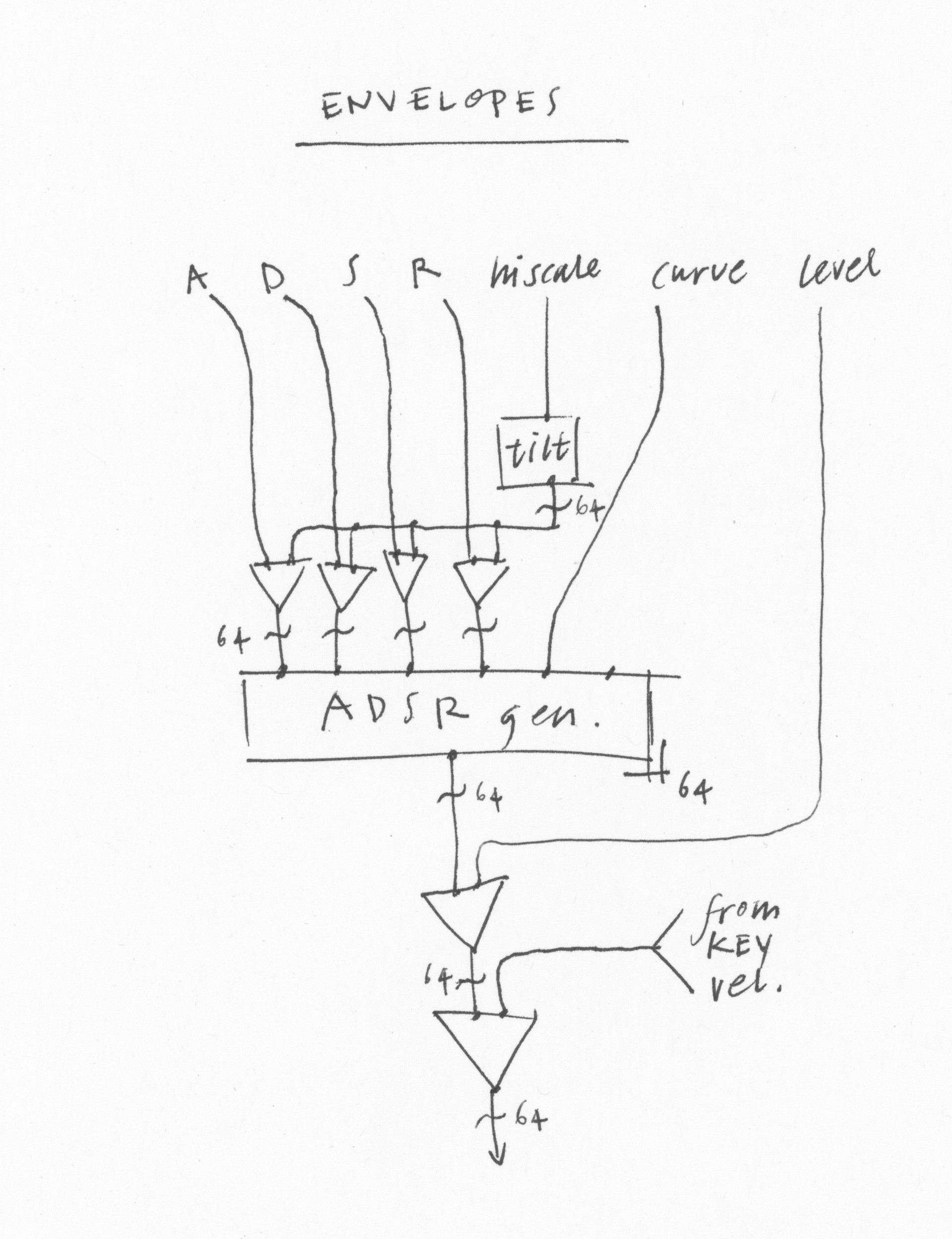
Another way of generating control data is with the ENVELOPES module. It’s a normal envelope generator more or less—except that it generates 64 separate envelopes, one for each partial. Generally you would trigger them all at the same time, but each does have its own trigger so they can be separate. Using the “hi scale” parameter the high envelopes will be quicker than the low ones, making a very natural kind of lowpass contour to the sound.
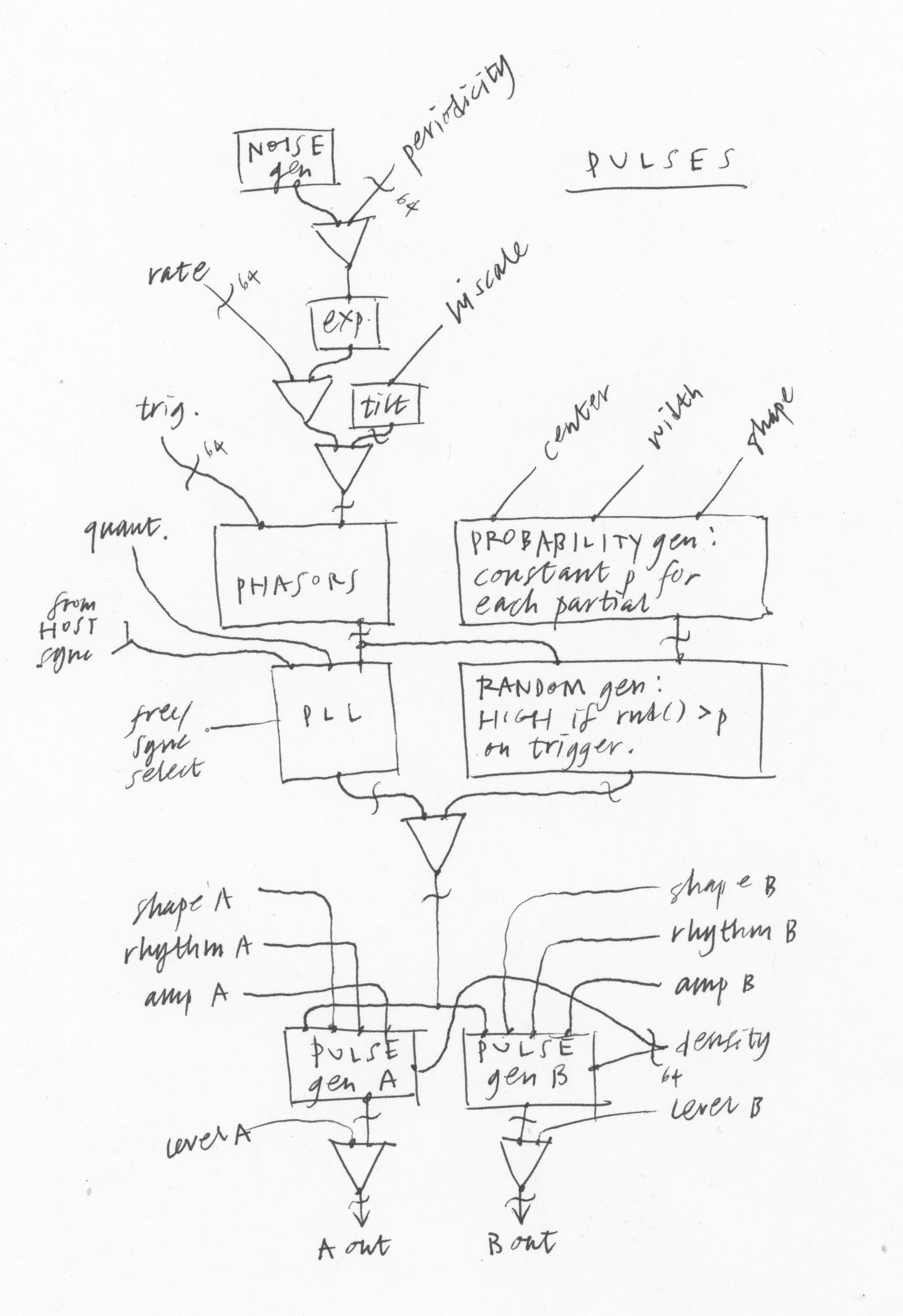
Finally on the top row there’s the PULSES module. This combines an LFO and a randomness generator into one module. The intensity and other parameters of the pulses can be different for every partial. So this makes modulations that can be focused on a certain frequency range, but you don’t have to mess around editing partials one by one. You could also, for example, use the pulses to trigger the envelopes all at different times.
The PULSES module was inspired by my walks in a small canyon near my house, and listening to the very finely detailed and spatially spread sounds of water running in a small creek. Each drop contributes something to the sounds and the interplay between the parts and the whole is endlessly intriguing.
To make a water drop sound, two envelopes are needed at the same time: a rise in pitch and an exponential decay in amplitude. So PULSES lets you put out two such envelopes in sync. Then of course we generalize for a wider range of functions, so we can find out, what if the drops were quantized, or had different shapes over time? A voice turning into a running river is the kind of scene that additive synthesis can paint very sensitively. The PULSES module is designed to help create sounds like this.
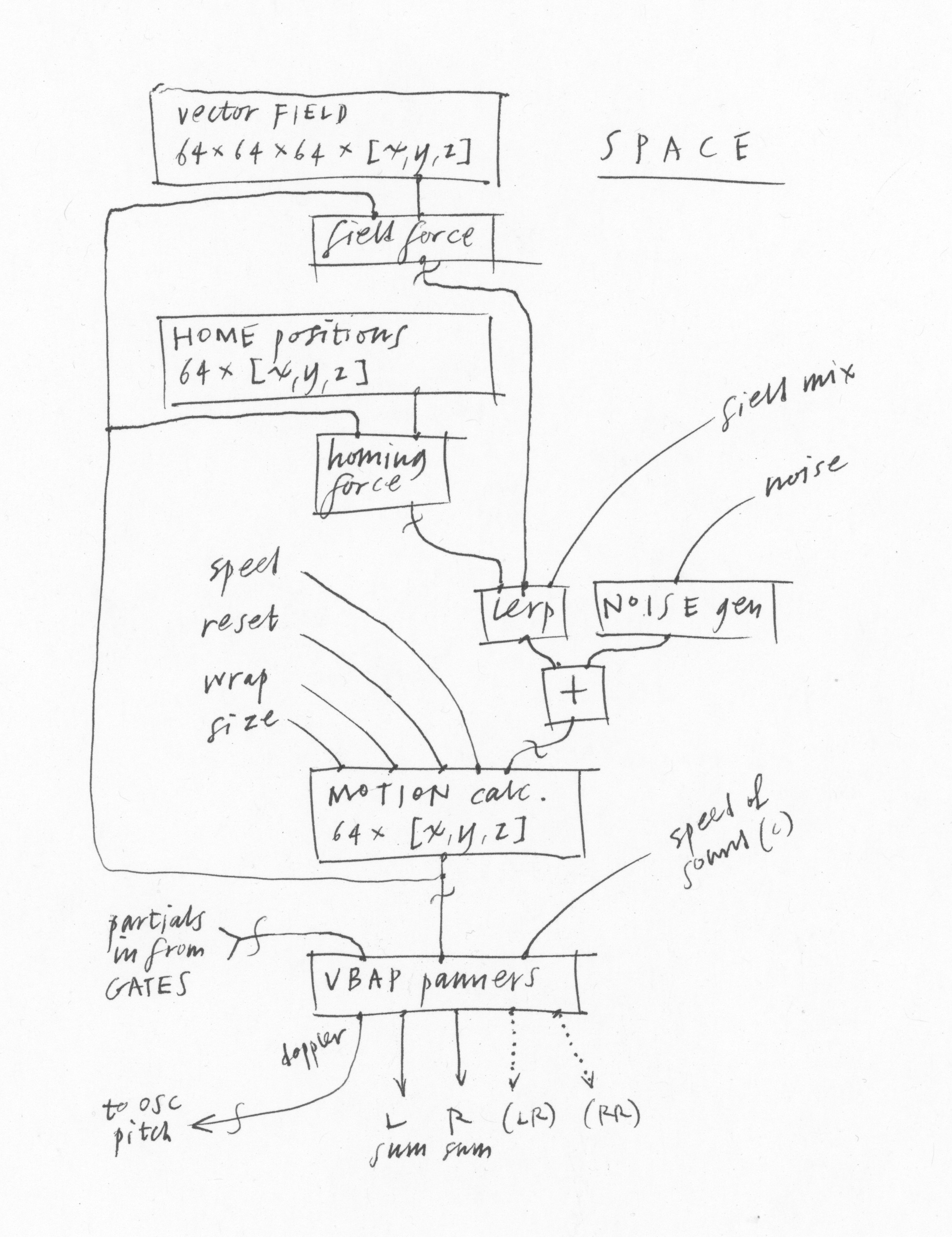
The SPACE module lets us position each partial in the sound independently. Coming back to the creek idea, we can hear that certain pitch ranges happen in certain locations around us due to the water speed and the resonances of different cavities. This all paints a lively acoustic scene. By positioning many little drops independently, while allowing some variation, we can approximate this kind of liveliness.
This module centers around two kinds of data, a set of positions for each partial known as home, and a vector field: a direction [x, y, z] defined at each point in a 3-dimensional space. There will be a set of both the home and the field patterns to choose from. By offering these choices, and a small set of parameters controlling the motion of the partials, such as speed, the homing tendency, and the strength of the vector field, we can quickly create a wide variety of different sonic spaces without the tedium of editing each partial independently.
The RESONATORS module is very simple and inspired by the section of the Polymoog synthesizer with the same name. It’s simply three state-variable filters in parallel, with limited bandwidth and a bit of distortion for that “warm” sound. In Sumu, a synth we could otherwise describe as “very digital,” it’s nice to have a built-in way of adding a different flavor.
So I have this interface you see above, and a sound engine, and I'm working feverishly to marry the two. To enable all of the animations and the new pop-up menu, I wrote a whole new software layer that provides a completely GPU-based UI kit and interfaces directly with the VST3 library. Because it's been such a long process this time, I'm going to "build in public" more than I am used to doing, and have a public beta period. My plan is for this to start in December. Meanwhile I hope this information gives you interested folks something to whet your appetites, and even a basis for starting to think about what kinds of patches you might want to make.
Wow, I am excited. Looking forward for the beta...
Though I would like to see little enhanced envelopes. Not ADSR but APDSR Attack Peak Decay Sustain Release for real MPE fun. Standard ADSRs do not allow to have a soft attack and then a cressendo bigger than the first velocity would have defined. Just modulating a volume with pressure isn't the same especially for the releases... Would be great to get APDSR also for Kaivo and Aalto...
This is really exciting and the anticipation is even more painful now… wonder if I should sell my Paca.
This is great bravo! Glad things have kept developing up to this point. Can’t wait for the beta.
Amazing! Can’t wait to play with this!
Will the partials file import be in proprietary format or simple text that can potentially be outputted from OpenMusic or SPEAR?
Very excited to get my hands on Sumu!!!
Very much looking forward to hearing it. Looks to be plenty of opportunity to patch 'wrong' pairs too! Versatile use of note duration is a nice touch <3
As an owner of PPG Infinite, Harmor, and Loom II, I would love to try this out!!
Can’t wait to try this Randy, thanks for the sneak peek.
Beautiful work as always, I can't wait to hear it. Love 'Home' and 'Field', such a great way to approach it. Thanks for sharing your process.
Thrilled that this is finally coming
Randy, looks like some nice work. Looking forward to it.
AAAAAAAAAAAAAAAAAAAAAAAH I LOVE IT SO MUCH ALREADYYYYYY
Fantastic news! I am also very excited to hear that it comes to final stage. I would love to test the beta too,,,
These are the days. Randy, your work continues to inspire and create advanced forms of communication. Special things take time, chaos, fear, love, attitude, and letting go. This is already special and I'm looking forward to it in every sense of the word. Creation is Magic
So excited
Bravo ! Superb concept, beautiful layout, no doubt it will sound new and exciting ! Just like your previous work.
Can't wait to test the beta !
Thanks for the news !
Latest newsletter brought me here. Always excited to receive news from you. Count me among the people that are eagerly anticipating Sumo. Very interesting description and I love the grey color scheme.
"learn" can only be for midi learn functionality, right? Please add that to Aalto and the others as well in the future :-)
Wow, this seems incredible, can't wait to play this with the Linnstrument!
Congratulations, Randy! This is really exciting. Looking forward to playing with Sumu.
My goodness, this looks amazing! I’m really looking forward to get this and play with it as soon as it gets released!!!
Like a good wine my friend. ![]()
Is 64 partials using the parallel side of the Intel processor?
Like Fathom Synth or Spectrasonics material?
Either way, I love your work and look forward to both SUMU and Altoverb 2.
This seems very very promising. <3 Great work.
Wow! Sounds like another must-have synth. Very interesting synth architecture again, but with the way these synths are patched, it will be intuitive and fun to work with, just like the others. Well done.
I am sometimes tempted just to sell all my hardware synths and focus entirely on the Madrona ones as they offer so much uniqueness and sonic flavour.
Oh man...this looks really good. Looking forward to its release !
That look great Randy. My only concern is the GPU utilisation. Maybe a little system tester prior to deciding whether the GPU is capable enough might make me think my system will run it properly with an alternative routing to use more CPU core capability. Just a thought as my system is apparently not capable of upgrading to Windows 11
CPU AMD Ryzen 7 1700 Eight-Core Processor 3.00 GHz
RAM 40.0 GB
Windows 10 Pro version 21H1 OS Build 19043.1348
GPU AMD Radeon R7 200 series 400MHZ (0x6613)
In my relatively short music adventure (going on 3 years now since I got into all this stuff), never have I
A) purchased one developer's entire catalogue so quickly after trying the first product. B) been so excited for a new release!
Your attention detail and eye/ear for design is unmatched. The beautiful aesthetics brought me here - the sound and experience have me salivating for more!
Looking forward to trying out Sumu!
Much love from Las Vegas, NV!
FINALLY... and of course you're the one who made this per-channel-partials synth. I cannot wait to let my new embodme Erae Touch make it sing
I am so exciting~Waitting for this for so long time and finally~~Thanks!!
Can not wait! Your sound-making playthings are magical. like rad and so too cool. Seriously I love your plugins. Looking very much forward to what you've done with Sumu
Where do I pre-order? This looks like it's going to be awesome.
Looks great! Can’t wait to try it! I too have an Embodme Erae Touch that would be a blast with this synth.